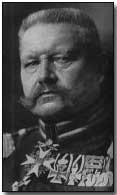Primary Documents - U.S. Ambassador to France on the German Retreat to the Hindenburg Line, April 1917
 Reproduced below is the
reaction of the former U.S. Ambassador to France, William Sharp, upon
witnessing at first hand French territory in the wake of the retreat of
German forces to the Hindenburg Line in the Spring of 1917.
Reproduced below is the
reaction of the former U.S. Ambassador to France, William Sharp, upon
witnessing at first hand French territory in the wake of the retreat of
German forces to the Hindenburg Line in the Spring of 1917.
Sharp's views were similar in tone to those expressed by his counterpart in Austria-Hungary, Frederic C. Penfield. This is perhaps unsurprising given that America entered the war shortly afterwards.
Click here to read the text of the official French report into alleged excesses of German forces in France during the retreat. Click here and here to read memoirs of the retreat to the Hindenburg Line as witnessed by two noted German journalists. These bear out French claims of wanton destruction by German troops but offer a spirited defence of its rationale.
U.S. Ambassador to France, William Sharp, on the German Retreat to the Hindenburg Line
Paris, April 1, 1917,
Secretary of State,
Washington.
Accepting an invitation, kindly extended to me several days ago, I yesterday visited many of the French towns recently retaken in the invaded territory, making the trip in a military automobile. I was accompanied by military attaché Boyd.
I regret to say that I found the various reports in circulation here, and doubtless forwarded to American newspapers, of the deplorable conditions in those towns are in no way exaggerated. With very few exceptions the places visited by me, though few in comparison, numbering upwards of thirty, had been quite destroyed by the Germans before evacuating them.
The destruction wrought in the larger towns of Roye, Ham, and particularly the once thriving and attractive city Chauny, was complete. In many of the other smaller villages scarcely a house remains with its roof intact. A scene of desolation reigns everywhere over the reconquered territory.
This is true not alone where the possibly excusable military operations carried out by the Germans protected their retreat, by the blowing up of all the bridges and the destruction of the means of telegraphic and telephonic connections, including portions of railway lines, and the blocking of highways by the felling of many trees, but also where, as far as the eye could see, nearly all the fruit trees had either been cut down or exploded so as to completely ruin them.
Not only were the towns destroyed for no seeming military reason, but every private house along the country highways, including some of the most beautiful chateaux of great value, had been completely gutted by explosives or by fires systematically planned.
I am told that before the retreat commenced the agricultural implements found on the farms were also destroyed. Blackened walls of what must have been extensive manufacturing establishments were to be seen in many places, the salvage of which, including likewise that of most of all the other structures destroyed, would scarcely pay for the removal of the debris.
The churches and cathedrals in some of the towns had been reduced to a mass of ruins by the Germans either by heavy charges of explosives or by fires.
At Ham I was told by the mother of six children that her husband and two daughters, one of the age of fifteen and the other eighteen, had been carried away by the Germans at the time of their evacuating the town, and upon her remonstrating she had been told that as an alternative, she might find their bodies in the canal in the rear of her home.
The same woman informed me that out of that town's total population several hundred people had been compelled to accompany the Germans, nearly half of whom were women and girls above fifteen years of age.
There is the belief that a large number of French people in the evacuated towns and surrounding country were forced by the Germans to go with them in their retreat, from the fact that so comparatively few are now to be found.
After traversing a distance of more than one hundred miles in this invaded territory, I left with the conviction that history records no parallel in the thoroughness of destruction wrought either by a victorious or a vanquished army.
Source: Source Records of the Great War, Vol. V, ed. Charles F. Horne, National Alumni 1923
A "British warm" was a heavy issue greatcoat for officers.
- Did you know?
